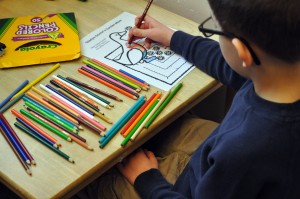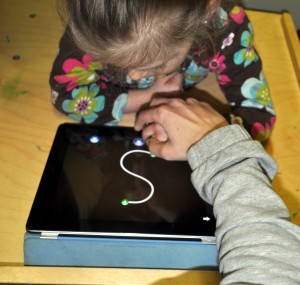Children who try to write before they have sufficient skill to manipulate the pencil tend to develop inappropriate motor memory for writing letters inefficiently. Learning to write demands complex memory, motor performance and perceptual skills (there can be a large age difference with some children in K). Writing requires selective attention to and remembering of letter formation, correct spelling, mechanics of grammar, punctuation and formulation of a sequential flow of ideas.
There are several skills and processes going on when a child tries to write. In order to be able to write and develop a grasp, a child must have the stability within their trunk and shoulders to hold their body and arms up. Pencil grips help to position the fingers, but do not provide the stability that is needed to write. This stability comes from strength in the shoulders and trunk. They must have the control and strength in their fingers to hold and move the pencil.
The therapist might also work on letter formation, spacing and/or directionality of the letters. These skills also rely on the child’s visual motor integration, visual perceptual and motor planning abilities. The ability to use two sides of the body together or reciprocally in a coordinated manner is essential for development of laterality, the measurable superiority of one side over the other in terms of performance. Bilateral integration is the ability to use two sides of the body together or reciprocally in a coordinated manner. It is essential for development of laterality and dominance. As the two hemispheres of the brain mature dominance should begin to appear. The left hemisphere is responsible for analyzing, sequencing, logic, and verbal language. The right hemisphere is responsible for three dimensional spaces and generating visual images and maps. The left side thinks in words and the right side relies on images and spatial awareness. Both hemispheres must work together when creating written words. A child may not form a good mental image of what is wanted or may produce the image but is not able to execute it. Poor visual memory for what a letter should look like may be the problem. Motor planning depends on the ability to consistently retrieve a motor pattern or letter in order to reproduce it.
At Home Activities:
- Using tweezers/tongs to pick up objects
- Playing with Wiki Stiks or Play Doh to create numbers/letters
- Write with smaller crayons, pencils, etc. This allows the finger tips to hold the utensil rather than the hand
- Trace letters with a Q-tip and paint
- Find and pick small objects out of putty
- Use a stylus when working on an iPad
- Use paper with a darkened or highlighted line to help the child recognize where the letters start
- Animal walks to strengthen the shoulder/trunk muscles

- Writing/drawing on an easel or vertical surface
- Tracing using stencils
- Punching holes in paper using a single hole punch
- Tape a piece of paper to the underside of a table and lay under the table to draw
- Therapy ball exercises
- Board games with small pieces
- “Pencil Walk” moving the fingers up and down the pencil
- Sidewalk chalk on pavement, chalkboards and loop pile carpet squares
- Pushing gold tees into dense Styrofoam or pool noodles
- Use graph paper to help with letter sizing and spacing. Write with one letter per box.
- Use blocks to make large letters on the floor
- Draw in the air using fingers, arms, legs etc
For More Information:

